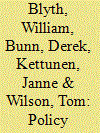|
|
|
Sort Order |
|
|
|
Items / Page
|
|
|
|
|
|
|
| Srl | Item |
| 1 |
ID:
111064


|
|
|
|
|
| Publication |
2012.
|
| Summary/Abstract |
The carbon market experiences of Brazil and India represent policy success stories under several criteria. A careful evaluation, however, reveals challenges to market development that should be addressed in order to make the rollout of a post-2012 CDM more effective. We conducted firm-level interviews covering 82 CDM plants in the sugar and cement sectors in Brazil and India, focusing on how individual managers understood the potential benefits and risks of undertaking clean development mechanism (CDM) investments. Our results indicate that the CDM operates in a far more complex way in practice than that of simply adding a marginal increment to a project's internal rate of return. Our results indicate the following: first, although anticipated revenue played a central role in most managers' decisions to pursue CDM investments, there was no standard practice to account for financial benefits of CDM investments; second, some managers identified non-financial reputational factors as their primary motivation for pursuing CDM projects; and third, under fluctuating regulatory regimes with real immediate costs and uncertain CDM revenue, managers favored projects that often did not require carbon revenue to be viable. The post-2012 CDM architecture can benefit from incorporating these insights, and in particular reassess goals for strict additionality and mechanisms for achieving it.
|
|
|
|
|
|
|
|
|
|
|
|
|
|
|
|
| 2 |
ID:
092743


|
|
|
|
|
| Publication |
2009.
|
| Summary/Abstract |
Carbon pricing is an important mechanism for providing companies with incentives to invest in carbon abatement. Price formation in carbon markets involves a complex interplay between policy targets, dynamic technology costs, and market rules. Carbon pricing may under-deliver investment due to R&D externalities, requiring additional policies which themselves affect market prices. Also, abatement costs depend on the extent of technology deployment due to learning-by-doing. This paper introduces an analytical framework based on marginal abatement cost (MAC) curves with the aim of providing an intuitive understanding of the key dynamics and risk factors in carbon markets. The framework extends the usual static MAC representation of the market to incorporate policy interactions and some technology cost dynamics. The analysis indicates that supporting large-scale deployment of mature abatement technologies suppresses the marginal cost of abatement, sometimes to zero, whilst increasing total abatement costs. However, support for early stage R&D may reduce both total abatement cost and carbon price risk. An important aspect of the analysis is in elevating risk management considerations into energy policy formation, as the results of the stochastic modelling indicate wide distributions for the emergence of carbon prices and public costs around the policy expectations.
|
|
|
|
|
|
|
|
|
|
|
|
|
|
|
|
| 3 |
ID:
092812


|
|
|
|
|
| Publication |
2009.
|
| Summary/Abstract |
Bagasse power generation projects provide a useful framework for evaluating several key aspects of the Clean Development Mechanism of the Kyoto Protocol. On the positive side, our analysis, which draws in part from a data set of 204 bagasse electricity generation projects at sugar mills, indicates that these projects provide Annex I country investors with a cost-effective means to achieve greenhouse gas emissions reductions. Our analysis also confirms that the marketplace for Clean Development Mechanism-derived offsets is robust and competitive. Moreover, bagasse projects appear to provide a positive example in a "new wave" of clean energy investment that has replaced the earlier industrial gas projects. At the same time, we also identify two aspects of the CDM that demand improvement. First, the additionality standard needs to be tightened and made more transparent and consistent. Financial additionality should be required for all projects; however, any financial additionality test applied by the Clean Development Mechanism's Executive Board must be informed by the significant barriers faced by many projects. Second, the administrative processes for registration and verification of offsets need to be streamlined in order to prevent long registration time lags from chilling clean energy investment.
|
|
|
|
|
|
|
|
|
|
|
|
|
|
|
|
|
|
|
|
|